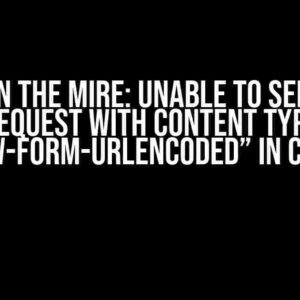Are you tired of struggling with updating TabularInline forms in Django Admin? Do you find yourself lost in a sea of code, unsure of where to begin? Fear not, dear developer, for this article is here to guide you through the process with ease. By the end of this comprehensive guide, you’ll be a master of updating TabularInline forms in no time!
What are TabularInline Forms?
Before we dive into the updating process, let’s take a quick refresher on what TabularInline forms are. In Django Admin, TabularInline forms allow you to display multiple related objects in a single row, making it easy to manage and update related data. They’re commonly used for one-to-many relationships, such as displaying multiple addresses for a single user.
Why Update TabularInline Forms?
So, why would you want to update TabularInline forms in the first place? Well, there are several reasons:
- **Improved User Experience**: Updating TabularInline forms can make it easier for users to manage related data, leading to a better overall user experience.
- **Increased Efficiency**: By allowing users to update multiple related objects at once, you can reduce the amount of time spent on data management.
- **Enhanced Data Integrity**: Updating TabularInline forms can help ensure data consistency and reduce errors by allowing users to update related objects in a single action.
Step 1: Prepare Your Model and Admin
Before we can update TabularInline forms, we need to prepare our model and admin. Let’s assume we have a simple model called `Book` with a one-to-many relationship with `Author`:
from django.db import models
class Author(models.Model):
name = models.CharField(max_length=50)
class Book(models.Model):
title = models.CharField(max_length=100)
author = models.ForeignKey(Author, on_delete=models.CASCADE)
Next, we need to create an admin for our `Book` model:
from django.contrib import admin
from .models import Book, Author
class BookAdmin(admin.ModelAdmin):
pass
admin.site.register(Book, BookAdmin)
Step 2: Create a TabularInline Form
Now that we have our model and admin set up, let’s create a TabularInline form for our `Author` model:
class AuthorInline(admin.TabularInline):
model = Author
extra = 1
fields = ('name',)
We’ll add this inline form to our `BookAdmin`:
class BookAdmin(admin.ModelAdmin):
inlines = [AuthorInline]
Step 3: Update the TabularInline Form
Now that we have our TabularInline form set up, let’s update it to include some custom functionality. Let’s say we want to add a `has_published` field to our `Author` model:
class Author(models.Model):
name = models.CharField(max_length=50)
has_published = models.BooleanField(default=False)
We’ll update our `AuthorInline` form to include this new field:
class AuthorInline(admin.TabularInline):
model = Author
extra = 1
fields = ('name', 'has_published',)
Customizing the Form with JavaScript
Sometimes, you may want to add custom JavaScript functionality to your TabularInline form. Let’s say we want to add a button to toggle the `has_published` field for all authors. We can do this by adding a custom JavaScript file to our admin:
// author_inline.js
(function($) {
$(document).ready(function() {
$('button.toggle-published').on('click', function() {
$.each($('. inline'), function() {
$(this).find('input[name="has_published"]').prop('checked', function(i,(val) {
return !val;
});
});
});
});
})(django.jQuery);
We’ll add this JavaScript file to our `BookAdmin`:
class BookAdmin(admin.ModelAdmin):
inlines = [AuthorInline]
class Media:
js = ('author_inline.js',)
Step 4: Render the Updated Form
Finally, let’s render the updated TabularInline form in our admin interface. We can do this by overriding the `changeform.html` template:
{% extends "admin/change_form.html" %}
{% block after_related_objects %}
{{ block.super }}
{% endblock %}
Conclusion
And that’s it! With these simple steps, you should now have a fully functional TabularInline form that allows users to update multiple related objects at once. By following this guide, you’ve taken the first step in mastering Django Admin and creating a seamless user experience for your users.
Troubleshooting Tips
Still having trouble getting your TabularInline form to work? Here are some common issues to check for:
- **Check your model relationships**: Make sure your models are correctly related and that you’ve defined the correct `foreignkey` fields.
- **Verify your admin configuration**: Double-check that you’ve correctly registered your admin and inline forms.
- **Debug your JavaScript**: Use the browser console to debug any JavaScript errors and ensure that your custom script is loading correctly.
Advanced Topics
Ready to take your TabularInline forms to the next level? Here are some advanced topics to explore:
- Using custom templates**: Learn how to customize the appearance and behavior of your TabularInline forms using custom templates.
- Implementing custom validation**: Discover how to add custom validation to your TabularInline forms to ensure data integrity.
- Using Ajax to update forms**: Explore how to use Ajax to update your TabularInline forms in real-time, reducing the need for page reloads.
Resources
Want to learn more about Django Admin and TabularInline forms? Check out these resources:
| Resource | Description |
|---|---|
| Django Admin Documentation | The official Django Admin documentation, covering everything from basic usage to advanced customization. |
| Stack Overflow – Django Admin | A collection of Django Admin-related questions and answers on Stack Overflow. |
| Full Stack Python – Django Admin | A comprehensive guide to Django Admin, covering topics from installation to customization. |
With these resources and this comprehensive guide, you’re well on your way to becoming a Django Admin expert. Happy coding!
Frequently Asked Questions
Get the lowdown on updating tabularinline forms in Django Admin!
How do I update a tabularinline form in Django Admin?
To update a tabularinline form in Django Admin, you can override the `save_formset` method in your admin class. This method receives the request and the formset as arguments, allowing you to perform custom validation and save logic.
Can I update multiple tabularinline forms at once in Django Admin?
Yes, you can update multiple tabularinline forms at once in Django Admin by using the `save_all` method provided by the `BaseInlineFormSet` class. This method saves all the forms in the formset, allowing you to update multiple related objects in a single request.
How do I handle errors when updating tabularinline forms in Django Admin?
When updating tabularinline forms in Django Admin, you can handle errors by using try-except blocks in your `save_formset` method. You can also use the `formset.errors` attribute to access any validation errors that occurred during the save process.
Can I customize the UI of tabularinline forms in Django Admin?
Yes, you can customize the UI of tabularinline forms in Django Admin by overriding the `render` method in your admin class or by using custom templates. You can also use CSS and JavaScript to customize the appearance and behavior of the form.
How do I validate data when updating tabularinline forms in Django Admin?
When updating tabularinline forms in Django Admin, you can validate data by using the `clean` method in your form class or by using custom validation logic in your `save_formset` method. You can also use Django’s built-in validation features, such as `ModelForm` and `FormSet`, to validate the data.



